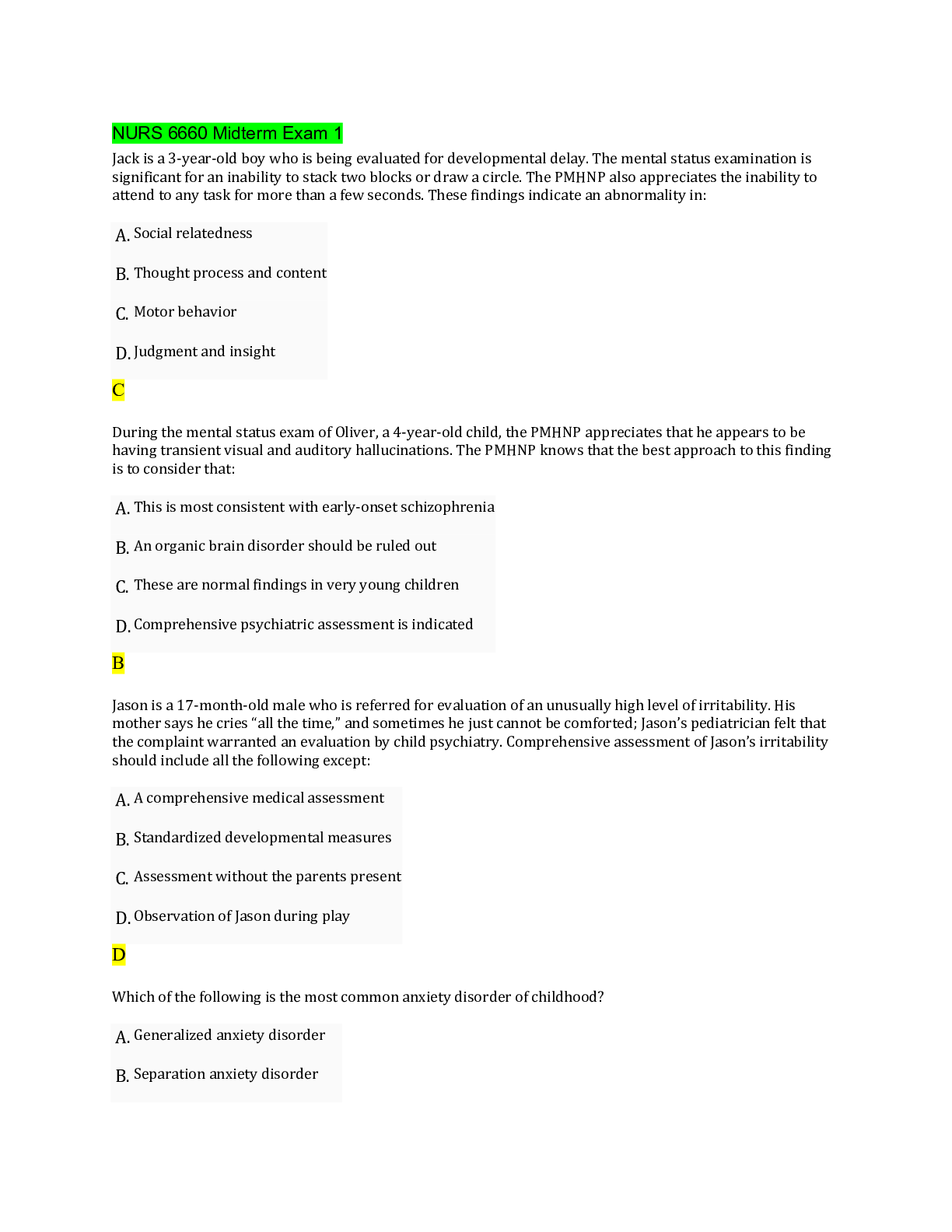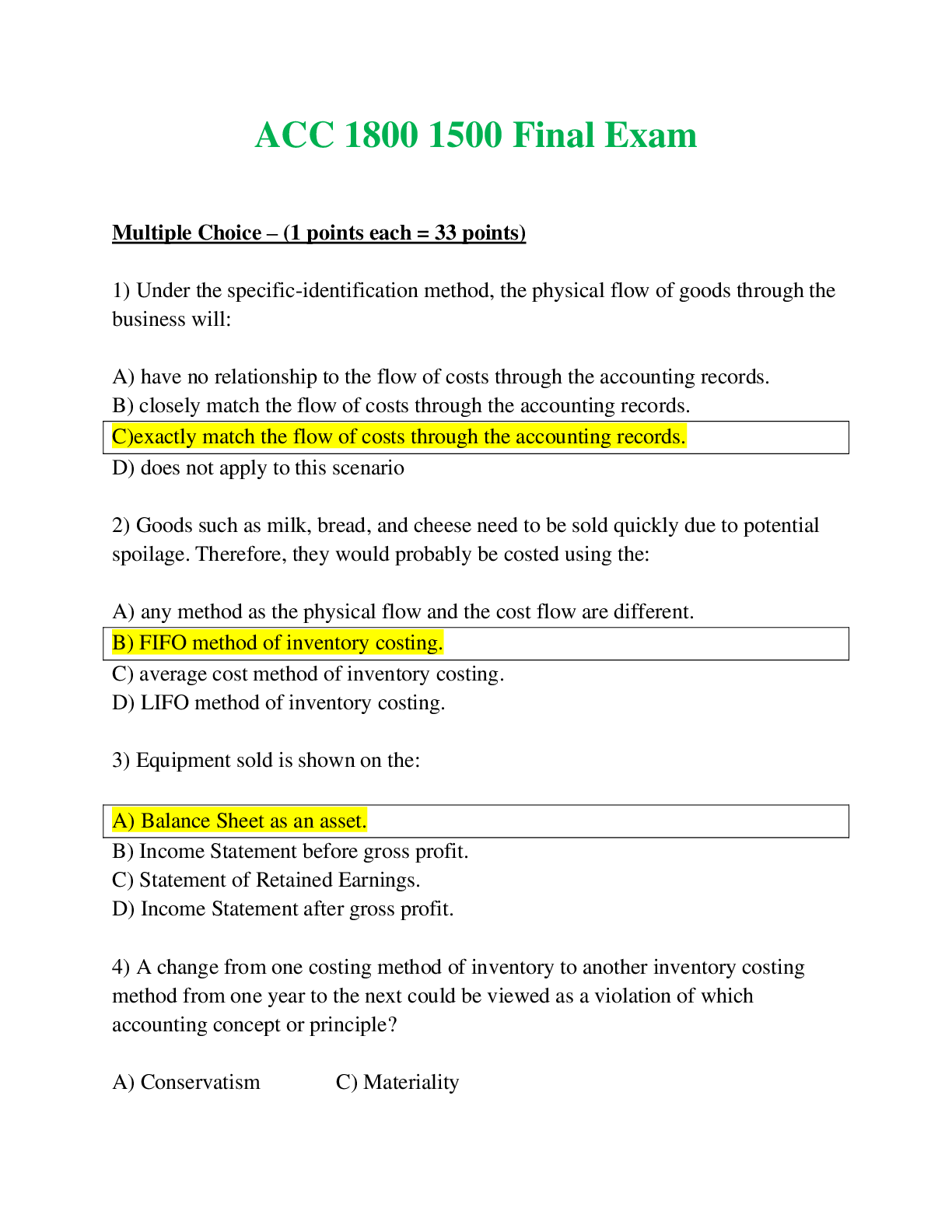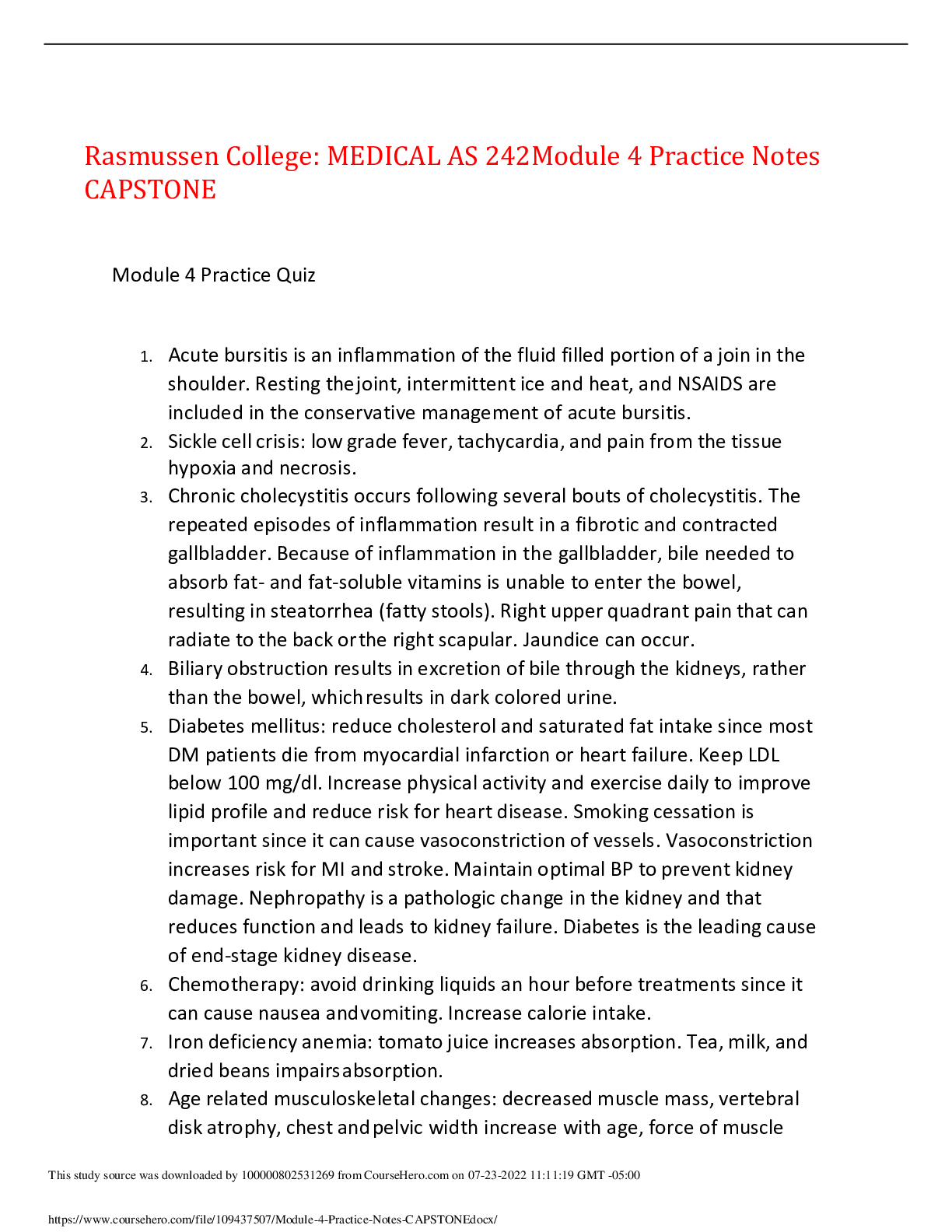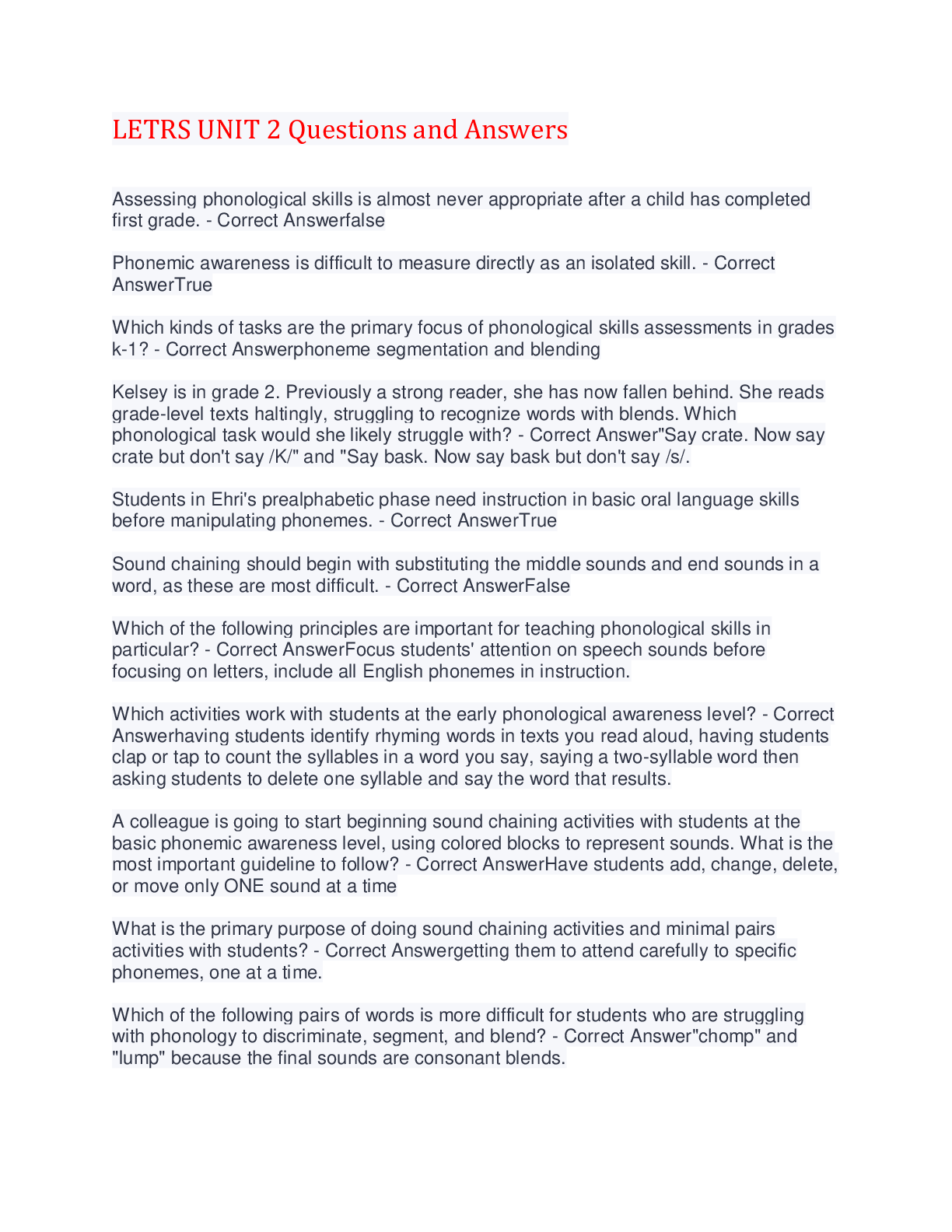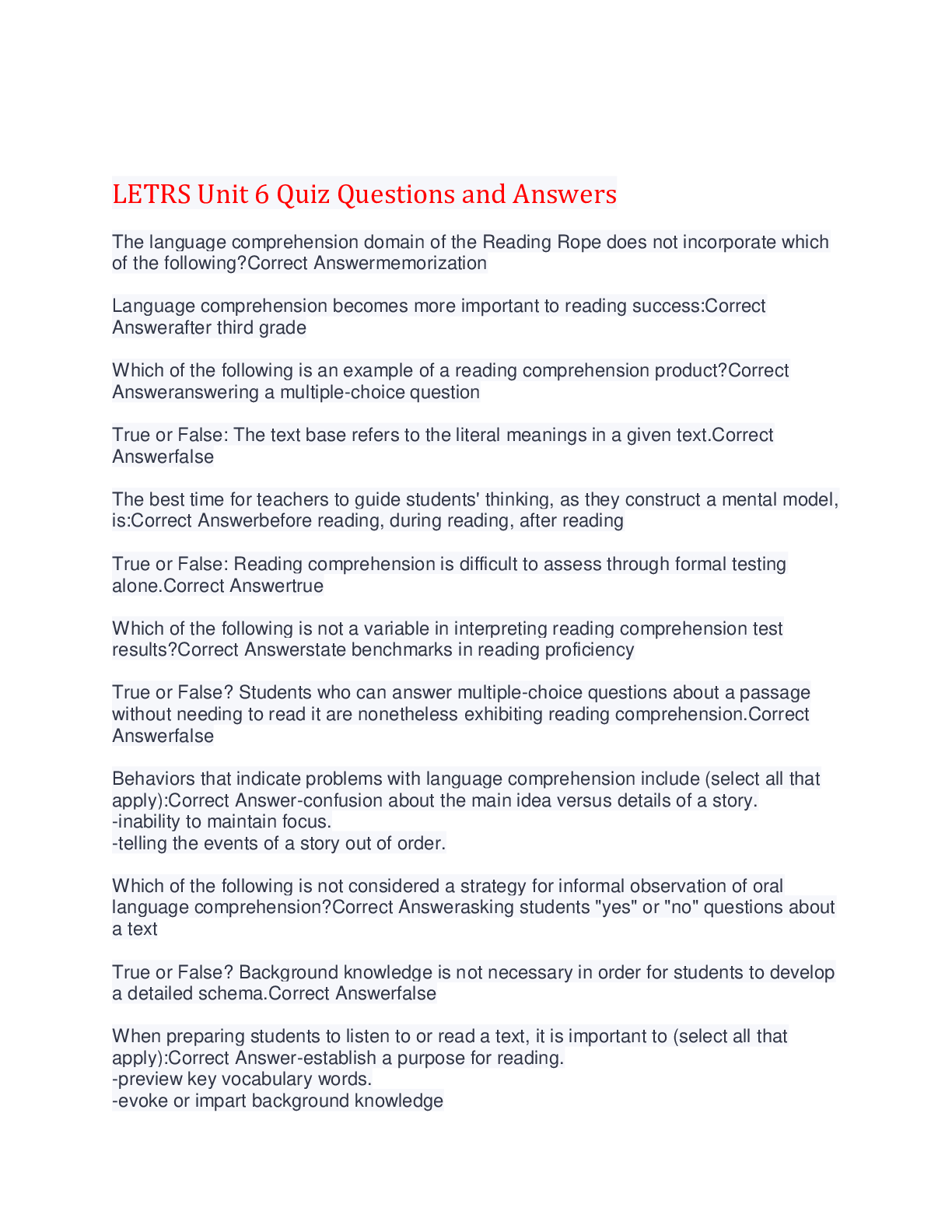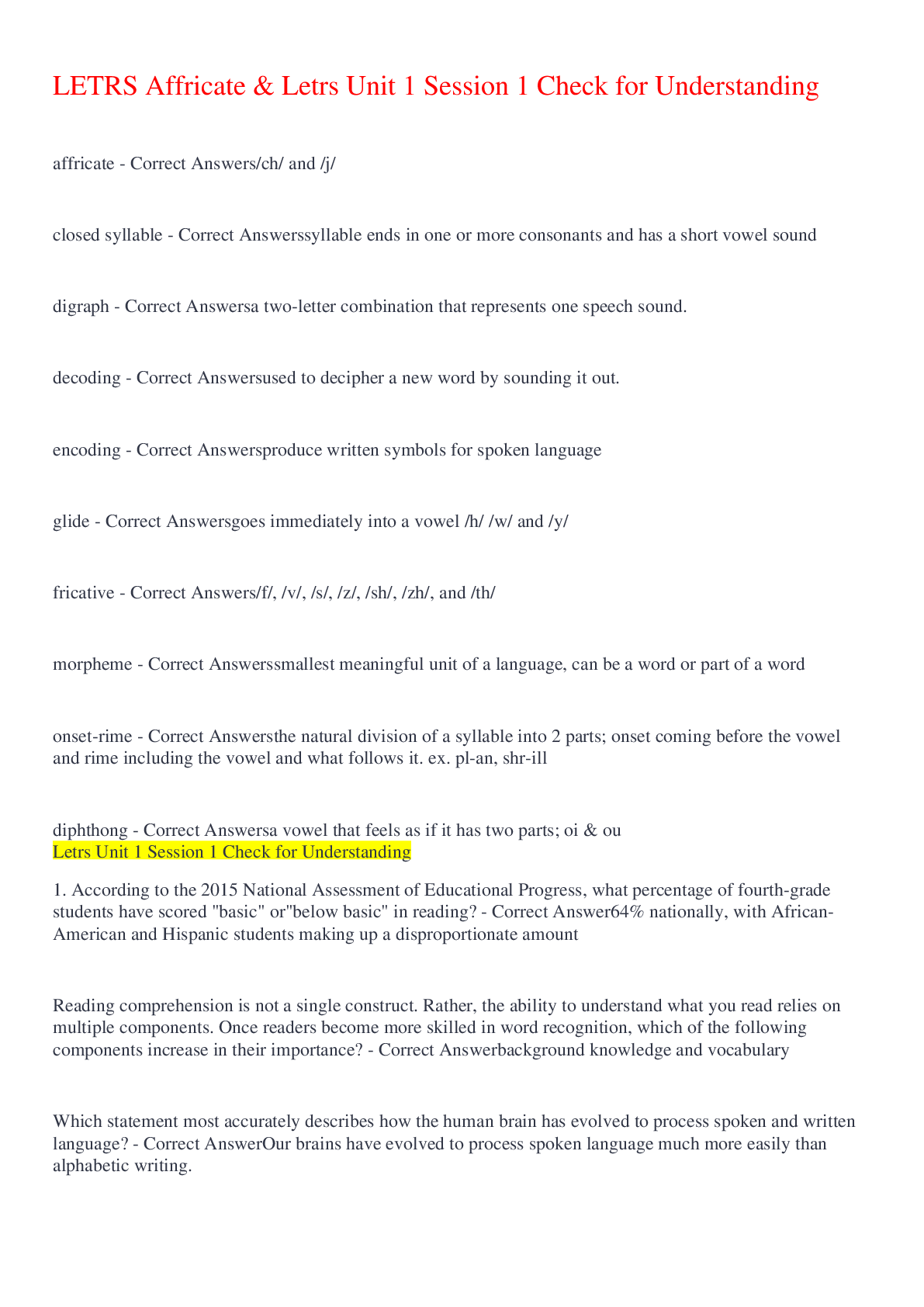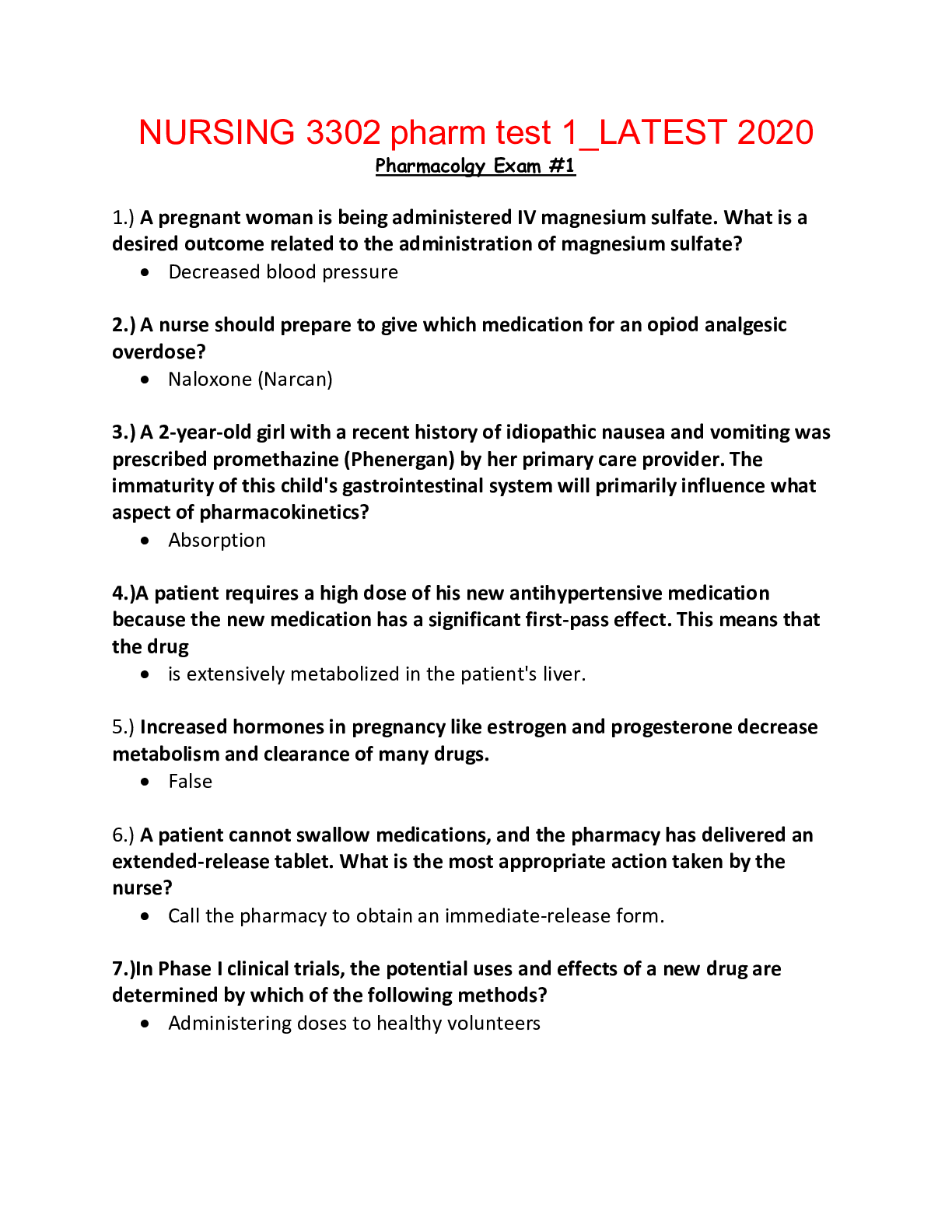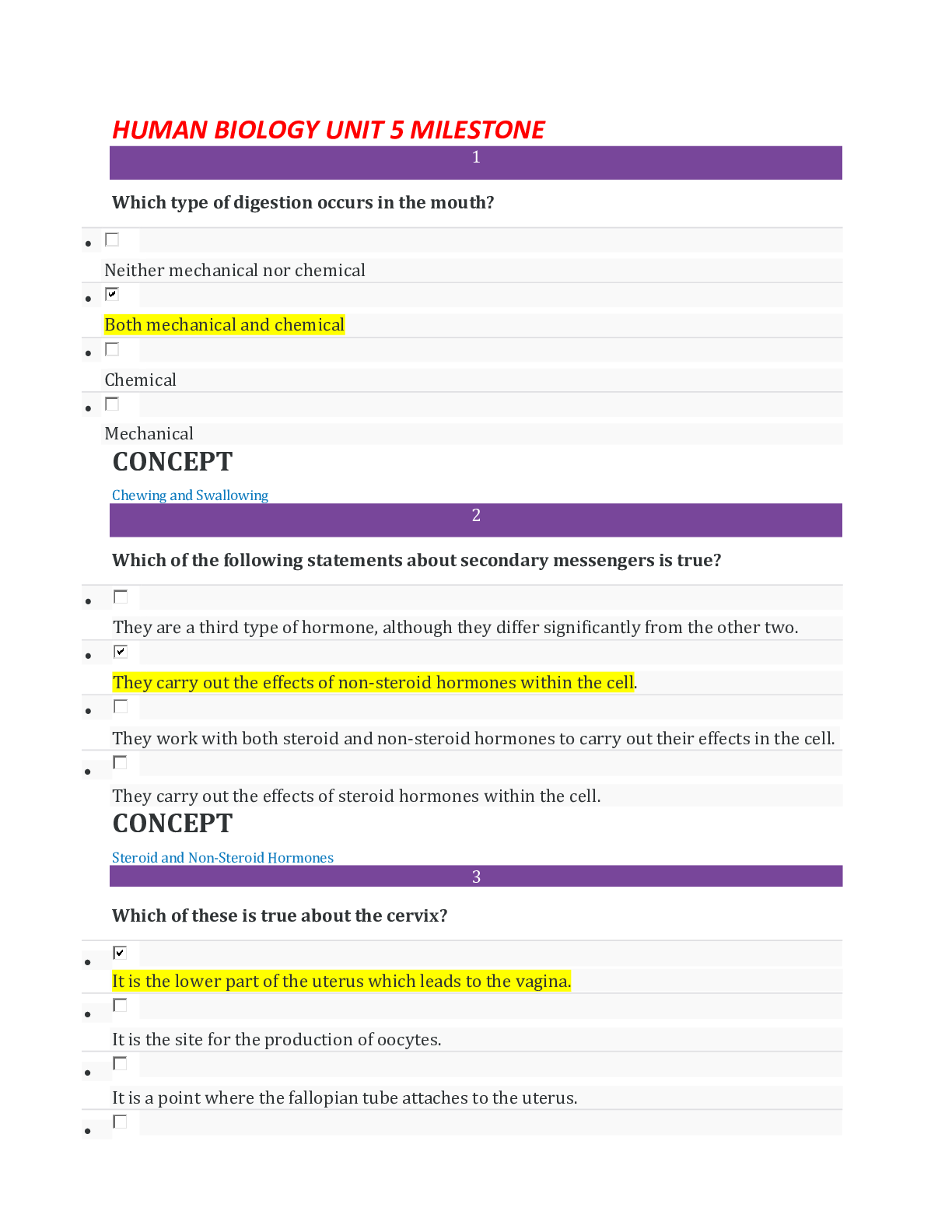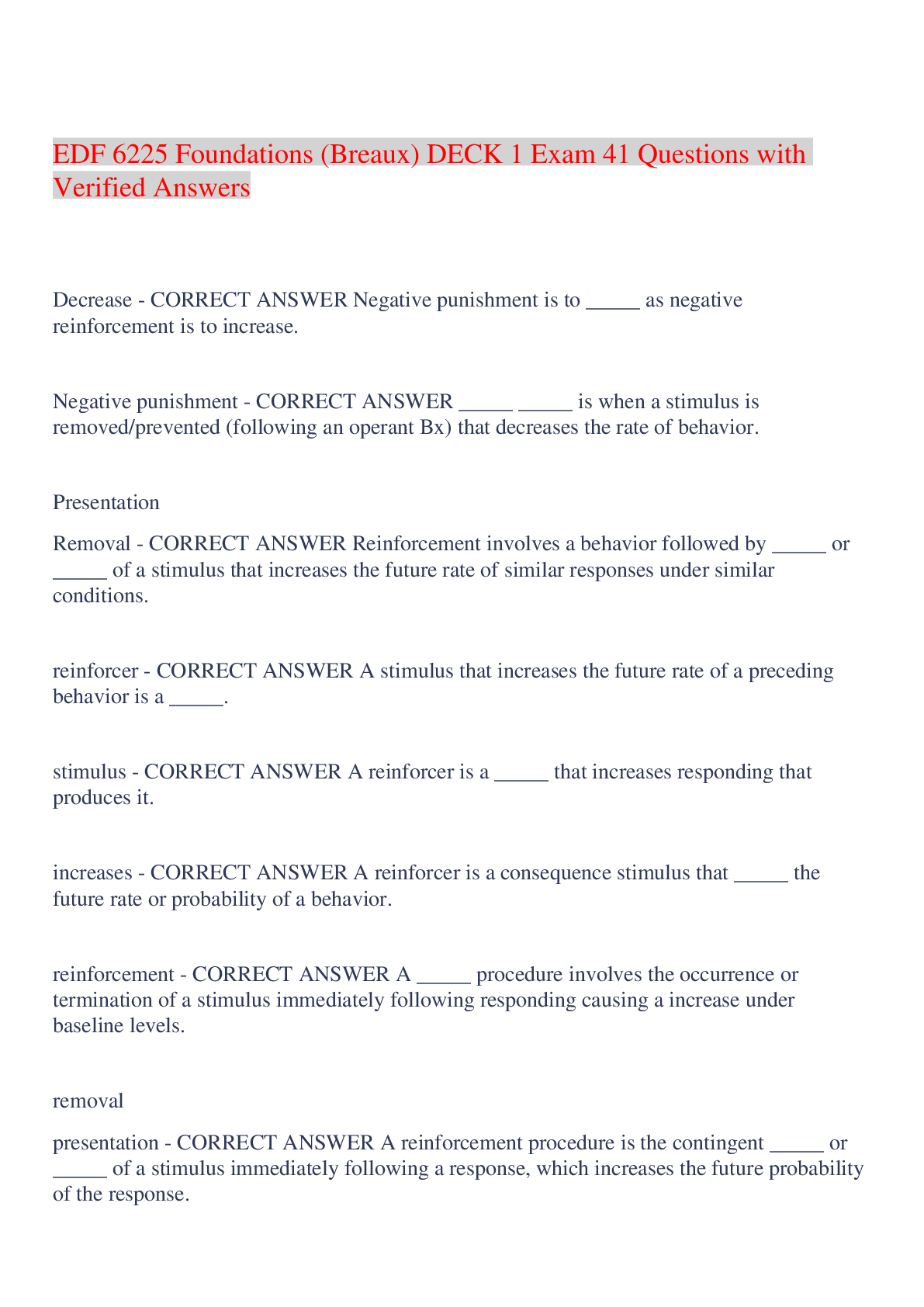NSG5002 FINAL EXAM 2020 QUESTIONS & ANSWERS,100% CORRECT
Document Content and Description Below
The most important partnership in a primary setting is between what two partners? Question 1 options: a) Practicing physicians b) Insurance and office manager c) Patient and provid... er d) Insurance and patient Save Question 2 (2.75 points) The goal of self-management is to specifically do what? Question 2 options: a) Engage patients in their own care b) Engage providers in patient care c) Engage government in greater involvement in patient care d) Engage insurance providers in patient care Save Question 3 (2.75 points) When there is a consequential loss of structural integrity of the abdominal aorta, the resulting issue is what condition? Question 3 options: a) Bloated stomach b) Bleeding ulcers c) Abdominal aortic aneurysm d) Kidney failure Save Question 4 (2.75 points) Aortic aneurysms are described based on their shape. Aneurysms may be fusiform or saccular. When an aneurysm forms as a weakness or bleb on one side of the aorta, it is described as what form of aneurysm? Question 4 options: a) Fusiform b) Saccular Save Question 55 (2.75 points) You receive a report back on the suspected abdominal aortic aneurysm for your patient. It confirms your suspicion of AAA. The report describes the aneurysm as a symmetric weakness of the entire circumference of the aorta. You know that this form of aneurysm is referred to as what kind of aneurysm? Question 5 options: a) Fusiform aneurysm b) Thoracic aneurysm c) Saccular aneurysm d) Budging sac aneurysm Save Question 6 (2.75 points) What is one of the common causes of a Saccular Abdominal Aneurysm? Question 6 options: a) Drugs: illicit and prescribed b) Poor kidney functioning c) Trauma d) Age Save Question 7 (2.75 points) Your patient has an AAA that you have been watching. It is now progressed to greater than 4.0cm in size. What action should you consider at this juncture in patient management of this condition? Question 7 options: a) Surgical consult with vascular surgeon b) Diet changes c) Prescription for ulcers d) Diuretic to lower fluid pressure Save Question 8 (2.75 points) Overall, the risk for abdominal aortic aneurysm is greater among: Question 8 options: a) Women b) Asian Americans c) African Americans d) Whites Save Question 9 (2.75 points) A 65-year old white male arrives in your clinic with general complaints of slight abdominal discomfort. He has a known history of smoking two packs per day for 40 years and hypertension. He also has COPD and has been treated numerous times with oral steroids. You consider several optional diagnoses. Of the ones listed below, which should be included as a potential top suspect in your choice of diagnosis? Question 59 options: a) Abdominal aortic aneurysm b) Meglacolon c) Chronic bowel obstruction d) Appendicitis Save Question 10 (2.75 points) Abdominal aortic aneurysms are often asymptomatic. What percent of AAA’s are discovered in asymptomatic patients? Question 10 options: a) 20% b) 10% c) 40% d) 75% Save Question 11 (2.75 points) Your patient asks you what causes a rupture of an abdominal aortic aneurysm. You know the answer is most often: Question 11 options: a) Trauma to the abdomen is most often the cause b) Ulcerations that “chew” through the abdominal wall c) Wall tension exceeds tensile strength of wall collagen d) Work or marital stress Save Question 12 (2.75 points) At what point is elective repair of an abdominal aortic aneurysm (AAA) for a healthy patient considered appropriate? Question 12 options: a) 1-2 cm diameter b) 10-15 cm diameter c) 5-6 cm diameter d) Baseball size Save Question 13 (2.75 points) You have confirmed that your patient does indeed have an abdominal aortic aneurysm. In teaching your patient about symptoms to report immediately to the vascular surgeon, you instruct the patient to report which of the following? Question 13 options: a) Back pain or flank pain b) Headaches c) Visual disturbances d) Newly diagnosed diabetes Save Question 14 (2.75 points) In a person with diagnosed abdominal aortic aneurysm, which symptoms might indicate impending rupture? Question 14 options: a) Headaches with pain radiating to the eyes b) Visual disturbances with halos around all lights c) New chronic illness diagnosis such as diabetes d) A deep boring pain that radiates to the legs Save Question 15 (2.75 points) More than half of all cardiac arrhythmias involve the atria. Question 15 options: a) True b) False Save Question 16 (2.75 points) At what age is atria fibrillation most common? Question 16 options: a) 60 years or older b) 45 years c) 30 years d) In childhood Save Question 17 (2.75 points) What are the most common mechanisms to produce cardiac arrhythmias? Question 17 options: a) Enhanced automaticity, triggered activity or reentry b) Reentry, electrical dysfunction or activity c) Stress, hard work or swimming d) Decreased automaticity, triggered activity or reentry Save Question 18 (2.75 points) Automaticity is a property common to all cardiac cells. Is this statement true or false? Question 18 options: a) True b) False Save Question 19 (2.75 points) What are the most common symptoms caused by tachyarrhythmias? Question 19 options: a) Sweating b) Headaches c) Palpitations d) Thirst Save Question 20 (2.75 points) Tachyarrhythmias cause a drop in commonly blood pressure, cardiac output, syncope, shortness of breath, and chest pain. What phenomenon most often occurs during these arrhythmias to cause these symptoms? Question 20 options: a) Shortened diastole b) Lengthened diastole c) Shortened systole d) Lengthened systole Save Question 21 (2.75 points) Your patient was recently treated for tachycardia and now has a normalized heart rate and rhythm. On examination, you notice a new S3 heart sound. What condition are you concerned with at this time based on this new finding? Question 21 options: a) Myocardial infarction occurring b) Impending heart failure c) Heart rupture d) Hypertension Save Question 22 (2.75 points) Your patient is newly diagnosed with persistent Atria Fibrillation. You consider electrocardioversion. Before undergoing this procedure you should order the following examination to assess thrombus risk. Question 22 options: a) Ultrasound of chest b) X-Ray of chest c) Tranesophageal echocardiography d) CT Scan Save Question 23 (2.75 points) Your patient presents with tachycardia. The QRS is measured at 0.10 seconds. Which of the following tachycardias would be an appropriate conclusion based on this information alone? Question 23 options: a) Premature junctional contractions b) Ventricular tachycardias c) Atria fibrillation d) Ventricular fibrillation Save Question 24 (2.75 points) Your patient presents with an atria arrhythmia with defined P waves. She is in stable condition and her hemodymics are stable. What would you suggest as a first line therapy in this case? Question 24 options: a) Beta Blockers b) Cardioversion c) Synchronized cardioversion d) Ablation therapy Save Question 25 (2.75 points) What are the two types of bradycardia recognized by the American Heart Association? Question 25 options: a) Refractory and non-refractory b) Relative and absolute c) Absolute and pending d) Relative and dynamic Save Question 26 (2.75 points) What criterion does the American Heart Association use to classify relative bradycardia? Question 26 options: a) Heart rate below 60 that does not support adequate cardiac output b) Heart rate above 60 that does not support adequate cardiac output c) Heart rate above 60 beats per minute d) Heart rate below 60 beats per minute Save Question 27 (2.75 points) Your 56-year old patient presents with bradycardia with a rate of 55 and first degree AV block. The patient is hemodynamically stable and is not experiencing any syncope or chest pain. History includes previous myocardial infarction. Home medications include beta blockers, daily aspirin. Lab work is non-significant for electrolyte imbalance. You decided to treat this patient for the arrhythmia to prevent future destabilization. From the choices below, which might be the appropriate first measure to consider? Question 27 options: a) Consult cardiologist immediately for guidance b) Atropine injections c) Add digitalis to control the heart rate d) Discontinue Beta Blocker and replace with another therapy if necessary Save Question 28 (2.75 points) Any patient presenting with symptomatic bradycardia should be referred to a cardiologist for management. Is this statement true or false? Question 28 options: a) True b) False Save Question 29 (2.75 points) The majority of all strokes are non-ischemic. Is this statement true or false? Question 29 options: a) True b) False Save Question 30 (2.75 points) Heart failure is a complex syndrome characterized by the heart’s failure to do which of the following? Question 30 options: a) Meet the body’s metabolic needs b) Pump sufficient blood to the brain c) Control for blood pressure d) Supply sufficient blood to the kidneys Save Question 31 (2.75 points) What are the two main types of heart failure? Question 31 options: a) Left sided and main b) End diastolic and pressure related c) Hopeless and severe d) Systolic and diastolic Save Question 32 (2.75 points) What is the most common cause of systolic heart failure? Question 32 options: a) Diabetes b) Atria arrhythmias c) CAD d) PAD Save Question 33 (2.75 points) Your patient of 58 years of age has chronic hypertension. You follow the guidelines for management as described by the American Heart Association and now have your patient fully medicated and dosed with three separate antihypertensive medications without control of the blood pressure. What should be your next step in the management of this patient? Question 33 options: a) Physician consult b) Add a fourth agent c) Increase exercise recommendations to include marathons d) Continue to observe for an additional three months without any changes Save Question 34 (2.75 points) You see a 60-year old African American male in your clinic with a recent diagnosis of hypertension. He asks you what he should restrict in his diet, and is particularly interested in limiting his sodium intake. What amount of sodium intake would you recommend on a daily basis for this patient? Question 34 options: a) 2.3 g/day b) 3.0 g/day c) No added table salt d) 1.5 g/day Save Question 35 (2.75 points) When a murmur is first heard, it is important to determine if it is due to a pathological condition or benign. For an experienced practitioner, it is always easy to determine the cause of a murmur merely by listening to the sound. Is this statement true or false? Question 35 options: a) True b) False Save Question 36 (2.75 points) You tell a patient that he has a murmur. He says he has been told this before, but wonders what causes the unique sounds of a murmur. Which of the following would be your best option? Question 36 options: a) Turbulent flow of blood b) High pressures caused from HTN c) Almost always from a sclerotic valve d) There is no reason, it just happens Save Question 37 (2.751 points) You see a 75-year old female in your clinic today complaining of urinary incontinence. She is otherwise healthy based upon her last visit. She states that her mother told her this would happen someday because it happens to every woman at some age. What would you tell this patient? Question 37 options: a) This happens to all women as they age b) No need to worry. This is normal. Your mother was correct. c) This is not an expected condition related to aging. d) This happens to men as well and most women before your age. Save Question 38 (2.75 points) Your patient presents complaining of incontinence of urine. He states that this happens every time soon after he urinates. What type of incontinence is your patient experiencing? Question 38 options: a) Stress incontinence b) Urge incontinence c) Overflow incontinence d) Mixed incontinence Save Question 39 (2.75 points) BPH is not a risk factor for Prostate cancer. Is this statement true or false? Question 39 options: a) True b) False Save Question 40 (2.75 points) Your 60-year old male patient arrives for his appointment. He complains of general malaise and fever over the past several days with low back pain. He also states that he is getting up at night more often to urinate and never feels his bladder is completely empty. What differential diagnosis should you consider in this patient? Question 40 options: a) Acute bacterial prostatitis b) Acute viral prostatitis c) BPH only d) Stomach virus Save Question 41 (2.75 points) You see a 35-year old male in the office for the first time. He states that he has been diagnosed with recurrent urinary tract infections. You know that urinary tract infections are uncommon among men less than 50 years of age and are considered a complicated infection in this age group. On physical examination, the patient is circumcised, and he denies homosexual activities. What other assessment or history question might be most pertinent in managing this patient? Question 41 options: a) Participation in heterosexual anal intercourse b) Cleanliness of anus after bowel movements c) Dietary habits d) Alcohol consumption Save Question 42 (2.75 points) Your patient has uncomplicated pyelonephritis. In deciding your recommended treatment, you consider the most common pathogenic reason for this diagnosis. What pathogen accounts for the majority of pyelonephritis? Question 42 options: a) Chlamydia b) E. Coli c) Mycoplasma Hominis d) Gardnerella Vaginalis Save Question 43 (2.75 points) There is a wide range of antibiotic agents that can be selected to treat a urinary tract infection. Unfortunately, there is often failure of treatment noticed. From the list below, which would be considered a common reason for treatment failure in UTI? Question 43 options: a) Inadequate treatment duration b) Selecting the appropriate antibiotic the first time c) Therapeutic dosing of the antibiotic d) Race or ethnicity of patient Save Question 44 (2.75 points) What is the treatment of choice for uncomplicated community-acquired cystitis? Question 44 options: a) Penicillin b) Amoxicillin c) TMP-SMZ d) Any antibiotic will treat this diagnosis Save Question 45 (2.75 points) For an uncomplicated UTI you choose to order TMP-SMZ for your patient. What is the recommended duration of therapy that you should considered? Question 45 options: a) 7-10 days b) 2 weeks c) 1 day d) 3 days Save Question 46 (2.75 points) What sexually transmitted disease is most widespread in the USA today? Question 46 options: a) Syphilis b) Gonorrhea c) Chlamydia d) HIV/AIDS Save Question 47 (2.75 points) Sexual partners of a patient with a diagnosed STI should always be examined and treated. Is this statement true or false? Question 47 options: a) True b) False Save Question 48 (2.75 points) The reason for the increase in chlamydia diagnosis is thought to be related to what event? Question 48 options: a) Increased sexual activities among all populations b) Increased sexual activity among males c) Increased screening efforts d) Actual increases in remission of the infection between partners Save Question 49 (2.75 points) Spread of genital herpes only occurs during the time period with active lesions. Is this statement true or false? Question 49 options: a) True b) False Save Question 50 (2.75 points) Skin cancer is the most common malignant neoplasm in males in the US. What is the second leading cause of cancer deaths in men greater than 50 years of age? Question 50 options: a) Lung cancer b) Prostate cancer c) Lymphoma d) Lupus Save [Show More]
Last updated: 2 years ago
Preview 1 out of 16 pages

Buy this document to get the full access instantly
Instant Download Access after purchase
Buy NowInstant download
We Accept:

Reviews( 0 )
$14.00
Can't find what you want? Try our AI powered Search
Document information
Connected school, study & course
About the document
Uploaded On
Oct 27, 2020
Number of pages
16
Written in
Additional information
This document has been written for:
Uploaded
Oct 27, 2020
Downloads
0
Views
98


